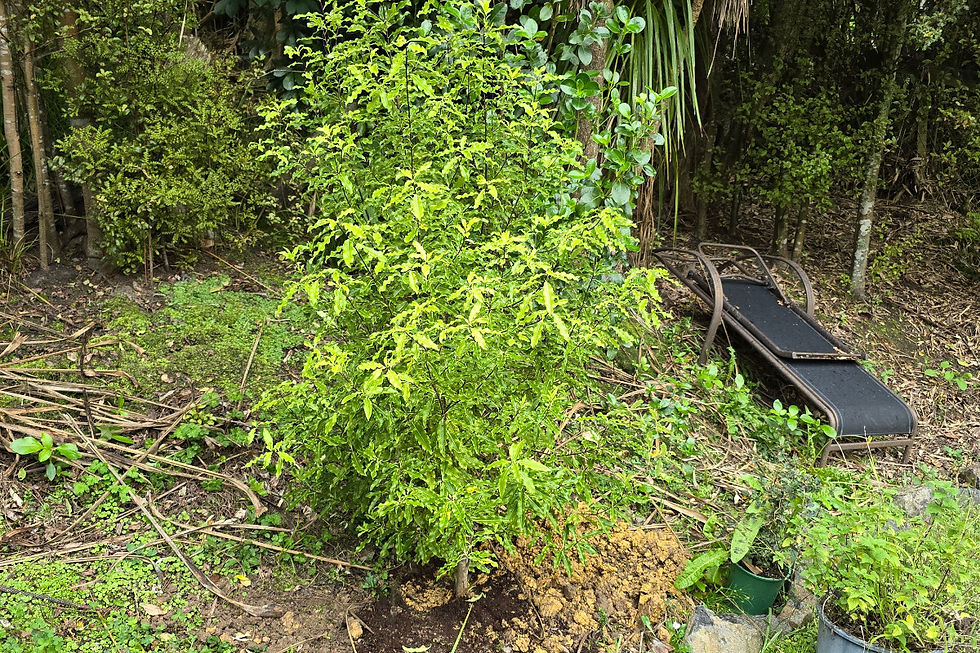Planting natives for wildlife habitats
- Birkenhead Butterflies

- Sep 8
- 4 min read
Nearly done with this year's restoration planting
September 2025
Since autumn, when the ground has been safe enough to walk the steep slopes of the garden (and on some bruising occasions when it wasn't), I've been planting native plants into the garden. Half of this garden is recovering bush / woodland and I am inserting additional plants in the main wooded area in the middle of the property to widen the plant diversity, create an understorey that will help support more wildlife, fill in gaps where we removed pest trees, and to hold the ground together where the soil is bare.

Landslips are a real concern and there is clear evidence of previous earth movements. Actually, a bank that would be perfect for glow worms was created at some point, but unfortunately I think there is simply too much light pollution and not enough humidity to support them currently. When the tree canopy is that much more complete, perhaps they will find their way into the garden. The nearest location I've seen them is Eskdale Bush, Hillcrest, on similar overhanging banks either side of the main path. You have to be brave enough to walk through without a torch though or they turn their lights off.

The plants I have been putting in are mainly bought from the Kaipātiki Project. Those fifty or so plants, grown locally from local seed, known as eco-sourced plants, represent hundreds of dollars worth of investment even at wholesale prices. I managed to bring them all back in one trip with my little Honda. I feel like they should have taken up more space, but once they grow, they will reflect all the money I spent on them!
They are not nearly enough to do the job - I didn't have enough money and I could not source all the plants I had planned for. Because of that I am trying to raise some plants from seed I have collected from local reserves. I am not the best at growing plants from seed, but the manuka have germinated recently and they will be happy on the slopes and are a great tree for geckos, stick insects and pollinators. Don't hold your breath for the other species of understorey plants, but you never know. Nature wants them to grow and I just have to not get in the way.
I left it too late in autumn to plant up the stream area. I went down to plant a puriri and sank in the mud. That is probably too much moisture for a puriri, so I planted it higher, made sure my boots came away with my feet and high-tailed it out of the gully. I planted grasses where the stormwater comes down like a cascade, but it wasn't until last weekend that I planted the remaining swamp grasses, swamp astelia and the kōtukutuku / tree fuchsia trees down at the bottom of the gully by the stream. I still sank and it was touch and go whether I would get out of there with my boots, but all the stream plants I had have now gone in.

The kids' trees that were planted have already put on good growth and are looking really healthy. The trees that I moved from the butterfly borders are also doing well, thankfully. They are great wildlife trees, even if they are not species I would have selected, so it is good they haven't curled up their roots and died. They are also much bigger than the new plants and will hold the ground together more quickly.

Couldn't I just let nature fill in the gaps? Yes, I could, but it is as likely that weed trees will sprout up. We are blessed with birds in this garden, but if the kereru have been eating loquats and drop those seeds, that is not a great tree for a native woodland area. I am hoping the kereru will bring in some native tree seeds though. Without planting them I would never get the kotukutuku here, even though they are a local species. Possums have wiped them out so efficiently from this part of the country that there are simply not enough around to repopulate easily.
There is plenty more work to do to restore this woodland. There are still some smaller monkey apples dotted around and weeds like broom and woolly nightshade keep springing up because of the open canopy. The woodland at the top of the garden may have had its last - and grandest - monkey apple removed a couple of weeks ago by arborists, but it is overgrown with invasive ginger and will take a lot of work to get it cleared. I still haven't planted the climbers I bought. Every job takes the garden one step closer to being a better habitat for wildlife in the long run. It will be a joy to see the new plants get established and flourish.



Comments